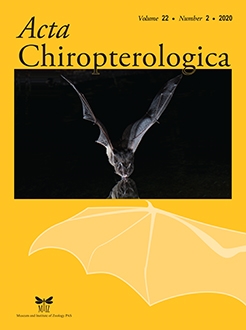Occupancy models have not been commonly used in studies focused on bat ecology, although they offer an opportunity to include site covariates along environmental gradients as well as factors that influence detection probability (e.g., lunar illumination). Here we assessed the influence of elevation and forest cover on occupancy and the effect of lunar illumination on detectability of bat species in the Northern Andes of Peru. We captured 1,052 bats, belonging to three families and 26 species, over two survey periods (2008–2010 and 2014–2015) at 14 sites. The most detected species were the frugivorous Artibeus glaucus, Carollia brevicauda, C. perspicillata, Platyrrhinus ismaeli, P. nigellus, Sturnira erythromos, and S. oporaphilum. Detection probability (p) of both Artibeus planirostris, C. brevicauda and C. perspicillata were significantly related to the survey period, while S. erythromos and S. oporaphilum detectability was associated with lunar illumination. Elevation was marginally positively associated with S. erythromos occupancy, with a moderate relative explanatory power based on AICc weight. We did not find support for an effect of forest cover on bat occupancy. The estimation of both bat occupancy (Ψ) and detectability (p) provides the basis for the design of monitoring programs with a spatiotemporal approach and constitutes a critical component in the context of land-use change and changing climate. For bat species in montane habitats, we suggest that S. erythromos is a useful species for use in monitoring programs, based on both occupancy, and detection probability, as well as its adaptability to montane areas.
How to translate text using browser tools
1 December 2020
Bat Occupancy Based on Mist-Netting Surveys in a Montane Landscape in Northern Andes
José L. Mena,
Sandra Velazco,
Edith Arias,
Katherin Bernabé
ACCESS THE FULL ARTICLE

Acta Chiropterologica
Vol. 22 • No. 2
December 2020
Vol. 22 • No. 2
December 2020
detectability
frugivorous bats
monitoring
montane forests
occupancy
Peru




